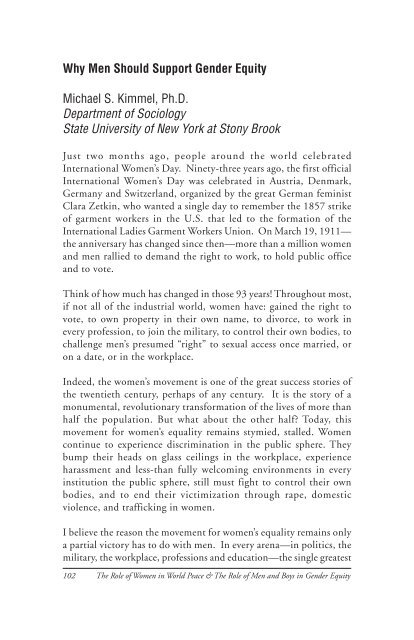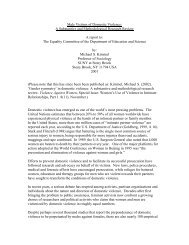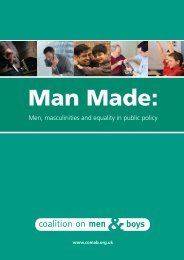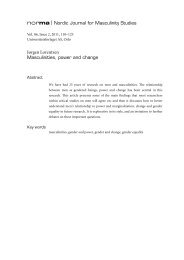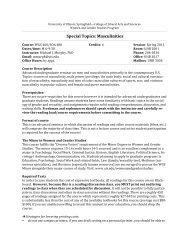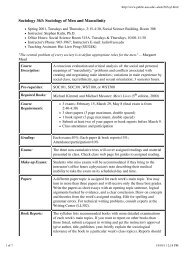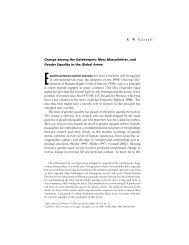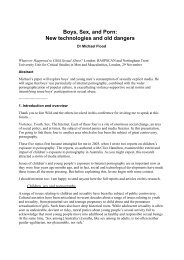Why Men Should Support Gender Equity Michael S ... - XY online
Why Men Should Support Gender Equity Michael S ... - XY online
Why Men Should Support Gender Equity Michael S ... - XY online
Create successful ePaper yourself
Turn your PDF publications into a flip-book with our unique Google optimized e-Paper software.
<strong>Why</strong> <strong>Men</strong> <strong>Should</strong> <strong>Support</strong> <strong>Gender</strong> <strong>Equity</strong><br />
<strong>Michael</strong> S. Kimmel, Ph.D.<br />
Department of Sociology<br />
State University of New York at Stony Brook<br />
Just two months ago, people around the world celebrated<br />
International Women’s Day. Ninety-three years ago, the first official<br />
International Women’s Day was celebrated in Austria, Denmark,<br />
Germany and Switzerland, organized by the great German feminist<br />
Clara Zetkin, who wanted a single day to remember the 1857 strike<br />
of garment workers in the U.S. that led to the formation of the<br />
International Ladies Garment Workers Union. On March 19, 1911—<br />
the anniversary has changed since then—more than a million women<br />
and men rallied to demand the right to work, to hold public office<br />
and to vote.<br />
Think of how much has changed in those 93 years! Throughout most,<br />
if not all of the industrial world, women have: gained the right to<br />
vote, to own property in their own name, to divorce, to work in<br />
every profession, to join the military, to control their own bodies, to<br />
challenge men’s presumed “right” to sexual access once married, or<br />
on a date, or in the workplace.<br />
Indeed, the women’s movement is one of the great success stories of<br />
the twentieth century, perhaps of any century. It is the story of a<br />
monumental, revolutionary transformation of the lives of more than<br />
half the population. But what about the other half? Today, this<br />
movement for women’s equality remains stymied, stalled. Women<br />
continue to experience discrimination in the public sphere. They<br />
bump their heads on glass ceilings in the workplace, experience<br />
harassment and less-than fully welcoming environments in every<br />
institution the public sphere, still must fight to control their own<br />
bodies, and to end their victimization through rape, domestic<br />
violence, and trafficking in women.<br />
I believe the reason the movement for women’s equality remains only<br />
a partial victory has to do with men. In every arena—in politics, the<br />
military, the workplace, professions and education—the single greatest<br />
102 The Role of Women in World Peace & The Role of <strong>Men</strong> and Boys in <strong>Gender</strong> <strong>Equity</strong>
obstacle to women’s equality is the behaviors and attitudes of men. I<br />
believe that changes among men represent the next phase of the<br />
movement for women’s equality—that changes among men are vital<br />
if women are to achieve full equality. <strong>Men</strong> must come to see that<br />
gender equality is in their interest—as men.<br />
This great movement for gender equality has already begun to pay<br />
attention to the fact that men must be involved in the transformation.<br />
The Platform for Action adopted at the Fourth World Congress on<br />
Women, in Beijing in 1995 said: “The advancement of women and<br />
the achievement of equality between women and men are a matter of<br />
human rights and a condition for social justice and should not be<br />
seen in isolation as a women’s issue.”<br />
But why should men participate in the movement for gender equality?<br />
Simply put, I believe that these changes among men will actually<br />
benefit men, and that gender equality is not a loss for men, but an<br />
enormously positive thing that will enable us to live the kinds of<br />
lives we say we want to live. Indeed, gender mainstreaming is an idea<br />
whose time has come—for men.<br />
In order to make this case, I will begin by pointing to several arenas<br />
in which women have changed so drastically in the past half-century,<br />
and suggest some of the issues I believe we men are currently facing as a<br />
result. First, women made gender visible. Women have demonstrated the<br />
centrality of gender in social life; in the past two decades, gender has<br />
joined race and class as the three primordial axes around which social<br />
life is organized, one of the primary building blocks of identity.<br />
This is, today, so obvious that it hardly needs mentioning. Parliaments<br />
have <strong>Gender</strong> committees, and the Nordic countries even have<br />
Ministers for <strong>Gender</strong> Equality. Every university in the U.S. has a<br />
Women’s Studies Program. Yet we forget just how recent this all is.<br />
The first Women’s Studies program in the world was founded in 1972.<br />
Second, women have transformed the workplace. Women are in the<br />
workplace to stay. Almost half the labor force is female. I often<br />
demonstrate this point to my university classes by asking the women<br />
who intend to have careers to raise their hands. All do. Then I ask<br />
Women’s Studies Review, Fall 2005 103
them to keep their hands raised if their mothers have had a career<br />
outside the home for more than ten years without an interruption.<br />
Half put their hands down. Then I ask them to keep their hands<br />
raised if their grandmothers had a career for ten years. Virtually no<br />
hands remain raised. In three generations, they can visibly see the<br />
difference in women’s working lives.<br />
Just 40 years ago, in 1960, only about 40% of European adult women<br />
of working age were in the labor force; only Austria and Sweden had<br />
a majority of working-age women in the labor force. By 1994, only<br />
Italy, Greece, Ireland, Luxembourg and Spain did not have a majority<br />
of working-age women in the labor force, and the European average<br />
had nearly doubled.<br />
This has led to the third area of change in women’s lives: the efforts<br />
to balance work and family life. Once upon a time, not so long ago,<br />
women were forced to choose between career and family. But<br />
beginning in the 1970s, women became increasingly unwilling to<br />
choose one or the other. They wanted both. Could a woman “have it<br />
all?” was a pressing question in the past two decades. Could she have<br />
a glamorous rewarding career and a great loving family?<br />
The answer, of course, was “no.” Women couldn’t have it all because…<br />
men did. It is men who have the rewarding careers outside the home<br />
and the loving family to come home to. So if women are going to<br />
have it all, they are going to need men to share housework and<br />
childcare. Women have begun to question the “second shift,” the<br />
household shift that has traditionally been their task, after the<br />
workplace shift is over.<br />
Finally, women have changed the sexual landscape. As the dust is<br />
settling from the sexual revolution, what emerges in unmistakably<br />
finer detail is that it’s been women, not men, who are our era’s real<br />
sexual pioneers. Women now feel empowered to claim sexual desire.<br />
Women can like sex, want sex, seek sex. Women feel entitled to<br />
pleasure. They have claimed their own sexual agency.<br />
And men; what’s been happening with men while women’s lives have<br />
so completely transformed? Not very much. While some men have<br />
changed in some ways, most men have not undergone a comparable<br />
104 The Role of Women in World Peace & The Role of <strong>Men</strong> and Boys in <strong>Gender</strong> <strong>Equity</strong>
evolution. This is, I think, the reason that so many men seem so<br />
confused about the meaning of masculinity these days.<br />
In a sense, of course, our lives have changed dramatically. I think<br />
back to the world of my father’s generation. Now in his mid-70s, my<br />
father could go to an all-male college, serve in an all-male military<br />
and spend his entire working life in a virtually all-male working<br />
environment. That world has completely disappeared.<br />
So our lives have changed. But men have done very little to prepare<br />
for this completely different world. What has not changed are the<br />
ideas we have about what it means to be a man. The ideology of<br />
masculinity has remained relatively intact for the past three<br />
generations. That’s where men are these days: our lives have changed<br />
dramatically, but the notions we have about what it means to be a<br />
man remain locked in a pattern set decades ago, when the world<br />
looked very different.<br />
What is that traditional ideology of masculinity? In the mid-1970s,<br />
an American psychologist offered what he called the four basic rules<br />
of masculinity:<br />
1) “No Sissy Stuff.” Masculinity is based on the relentless repudiation<br />
of the feminine. Masculinity is never being a sissy.<br />
2) “Be a Big Wheel.” We measure masculinity by the size of your<br />
paycheck. Wealth, power, status are all markers of masculinity.<br />
As a U.S. bumper sticker put it: “He who has the most toys when<br />
he dies, wins.”<br />
3) “Be a Sturdy Oak.” What makes a man a man is that he is reliable<br />
in a crisis. And what makes him reliable in a crisis is that he<br />
resembles an inanimate object—a rock, a pillar, a tree.<br />
4) “Give ‘em Hell.” Also exude an aura of daring and aggression.<br />
Take risks; live life on the edge. Go for it.<br />
The past decade has found men bumping up against the limitations<br />
of that traditional definition, but without much of a sense of direction<br />
about where they might go to look for alternatives. We chafe against<br />
the edges of traditional masculinity, but seem unable or unwilling to<br />
break out of the constraints we feel by those four rules. Thus, the<br />
defensiveness, the anger, the confusion that is evident everywhere.<br />
Women’s Studies Review, Fall 2005 105
These limits will become most visible around the four areas in which<br />
women have changed most dramatically: making gender visible, the<br />
workplace, the balance between work and home, and sexuality. They<br />
suggest the issues that must be placed on the agenda for men, and a<br />
blueprint for a transformed masculinity.<br />
Let me use these rules of manhood alongside the arenas of change in<br />
women’s lives and suggest some of the issues I believe we are facing<br />
around the world today. First, though we now know that gender is a<br />
central axis around which social life revolves, most men do not know<br />
they are gendered beings. When we say “gender,” we hear “women.”<br />
That gender remains invisible to men is a political process.<br />
I often tell a story about a conversation I observed in a feministtheory<br />
seminar that I participated in about a decade ago. A white<br />
woman was explaining how their common experience of oppression<br />
under patriarchy bound them together as sisters. All women, she<br />
explained, had the same experience as women, she said.<br />
The black woman demurred from quick agreement. “When you wake<br />
up in the morning and look in the mirror,” she asked the white<br />
woman, “what do you see?”<br />
“I see a woman,” responded the white woman hopefully.<br />
“That’s the problem,” responded the black woman. “I see a black<br />
woman. To me, race is visible, because it is how I am not privileged<br />
in society. Because you are privileged by race, race is invisible to you.<br />
It is a luxury, a privilege not to have to think about race every second<br />
of your life.” I groaned, embarrassed. And, as the only man in the<br />
room, all eyes turned to me. “When I wake up and look in the mirror,”<br />
I confessed, “I see a human being—the generic person. As a middleclass<br />
white man, I have no class, no race and no gender. I am<br />
universally generalizable. I am everyman.”<br />
Lately, I’ve come to think that it was on that day in 1980 that I<br />
became a middle-class white man, that these categories actually became<br />
operative to me. The privilege of privilege is that the terms of privilege<br />
are rendered invisible. It is a luxury not to have to think about race, or<br />
106 The Role of Women in World Peace & The Role of <strong>Men</strong> and Boys in <strong>Gender</strong> <strong>Equity</strong>
class or gender. Only those marginalized by some category understand<br />
how powerful that category is when deployed against them.<br />
While this story took place over 20 years ago, I was reminded of it<br />
recently when I went to give a guest lecture for a female colleague at<br />
my university. (We teach the same course on alternate semesters, so<br />
she always gives a guest lecture for me, and I do one for her.) As I<br />
walked in to the auditorium, one student looked up at me and said,<br />
“Oh, finally, an objective opinion!”<br />
All that semester, whenever my female colleague opened her mouth,<br />
what this student saw was “a woman.” Biased. But when I walked in,<br />
I was, in this student’s eyes, unbiased, an objective opinion.<br />
Disembodied Western rationality—standing right in front of the class!<br />
This notion that middle-class white men are “objective” and everyone<br />
else is “biased” is the way that inequalities are reproduced.<br />
This is why I think it’s important that I wear a tie. For what garment<br />
could better illustrate disembodied Western rationality, the mindbody<br />
dualism, than a garment where one end is tied in a noose around<br />
the neck and the other end points to the genitals?<br />
Let me give you another example of how privilege is invisible to those<br />
who have it. Many of you have email addresses, and you write email<br />
messages to people all over the world. You’ve probably noticed that<br />
there is one big difference between email addresses in the United<br />
States and email addresses of people in other countries: your addresses<br />
have “country codes” at the end of the address. So, for example, if<br />
you were writing to someone in South Africa, you’d put “za” at the<br />
end, or “jp” for Japan, or “uk” for England (United Kingdom) or<br />
“de” for Germany (Deutschland). But when you write to people in<br />
the United States, the email address ends with “edu” for an educational<br />
institution, “org” for an organization, “gov” for a federal government<br />
office, or “com” or “net” for commercial internet providers. <strong>Why</strong> is it<br />
that the United States doesn’t have a country code?<br />
It is because when you are the dominant power in the world, everyone<br />
else needs to be named. When you are “in power,” you needn’t draw<br />
attention to yourself as a specific entity, but, rather, you can pretend<br />
to be the generic, the universal, the generalizable. From the point of<br />
Women’s Studies Review, Fall 2005 107
view of the United States, all other countries are “other” and thus need<br />
to be named, marked, noted. Once again, privilege is invisible. In the<br />
world of the Internet, as <strong>Michael</strong> Jackson sang, “We are the world.”<br />
Becoming aware of ourselves as gendered, recognizing the power of<br />
gender as a shaping influence in our lives, is made more difficult by<br />
that first rule of manhood—No Sissy Stuff. The constant, relentless<br />
efforts by boys and men to prove that they are “real men” and not<br />
sissies or weak or gay is a dominant theme, especially in the lives of<br />
boys. As long as there is no adequate mechanism for men to experience<br />
a secure, confident and safe sense of themselves as men, we develop<br />
our own methods to “prove it.” One of the central themes I discovered<br />
in my book, Manhood in America was the way that American<br />
manhood became a relentless test, a constant, interminable<br />
demonstration.<br />
The second arena in which women’s lives have changed is the<br />
workplace. Recall the second rule of manhood: Be a Big Wheel. Most<br />
men derive their identity as breadwinners, as family providers. Often,<br />
though, the invisibility of masculinity makes it hard to see how gender<br />
equality will actually benefit us as men. For example, while we speak<br />
of the “feminization of poverty” we rarely “see” its other side—the<br />
“masculinization of wealth.” Typically, we express women’s wages as<br />
a function of men’s wages: in the E.U., women earn on average 83<br />
cents for every dollar of men’s hourly wages. But what is concealed is<br />
what we might see if women’s wages were the norm against which<br />
men’s were measured. <strong>Men</strong>, on average, earn $1.20 for every dollar<br />
women earn. Now suddenly privilege is visible!<br />
Women experience the glass ceiling—women are only 10% of all<br />
senior managers of U.S. Fortune 500 companies; only 3-5% of all<br />
senior managers in all U.S. companies. By contrast, men in “women’s”<br />
professions (say, librarian, nursery school teacher, nurse) ride a “glass<br />
escalator” to high-level managerial positions that will preserve their<br />
“masculinity.”<br />
Usually we believe that our career trajectories are the results of our<br />
individual characteristics, not the characteristics of the organization.<br />
A recent doctoral dissertation in economics by Ulla Eriksson at the<br />
University of Goteborg suggests otherwise. For two years, she followed<br />
108 The Role of Women in World Peace & The Role of <strong>Men</strong> and Boys in <strong>Gender</strong> <strong>Equity</strong>
five female and five male trainees in a large Swedish multinational<br />
corporation with 6,000 employees. All came from similar<br />
backgrounds, had similar education and had similar goals and<br />
ambitions. All ten aspired to top management positions. After their<br />
training, they all still were similar. At the end of the time, all the<br />
men and none of the women had entered the top management group.<br />
<strong>Why</strong>? Eriksson posited that it is the business culture—a culture that<br />
values “face time” over actual performance, penalizing women who<br />
work from home with sick children; a culture that makes balancing<br />
work and family nearly impossible for women, and the criteria for<br />
success itself.<br />
Now, remember, during the current economic downturn, fewer and<br />
fewer men are feeling much like big wheels. And here come women<br />
into the workplace in unprecedented numbers. Recently I appeared<br />
on a television talk show opposite three “angry white males” who felt<br />
they had been the victims of workplace discrimination. The show’s<br />
title, no doubt to entice a large potential audience, was “A Black<br />
Woman Took My Job.” In my comments to these men, I invited<br />
them to consider what the word “my” meant in that title, that they<br />
felt that the jobs were originally “theirs,” that they were entitled to<br />
them, and that when some “other” person—black, female—got the<br />
job, that person was really taking “their” job. But by what right is<br />
that his job? Only by his sense of entitlement, which he now perceives<br />
as threatened by the movement toward workplace gender equality.<br />
These anecdotes illustrate what to me are the central issues involved<br />
in integrating gender into our workplaces. Typically, we think we<br />
can create gender equality through “gender neutral” policies—policies<br />
that do not consider gender in hiring, salary or promotion. But such<br />
gender neutral policies fail to take into account the ways in which<br />
the very criteria by which people are evaluated are also gendered; the<br />
ways that the assumptions about what constitutes effective<br />
performance, leadership, or initiative are gendered. Stated most<br />
simply, gender neutral policies aren’t gender neutral. They are in fact<br />
deeply gendered.<br />
We need gender equal policies, not gender neutral policies. We are<br />
seen as gendered beings, and the processes by which we are evaluated<br />
Women’s Studies Review, Fall 2005 109
are gendered. When Lise Meitner, the famed German physicist, gave<br />
her first lecture at the University of Berlin in 1922 on “The<br />
Significance of Radioactivity for Cosmic Processes,” the newspapers<br />
reported her topic as problems of “Cosmetic processes.” And there’s<br />
an old adage in organizational studies that a man is unsexed by failure,<br />
but a woman is unsexed by success. Ambition, competence,<br />
competitiveness—these are still coded as masculine. Don’t believe<br />
me? How many of the women in this room were ever told “don’t be<br />
so smart, or you won’t get married.” Now, how many men were told<br />
anything even remotely like that?<br />
<strong>Gender</strong> equality in the workplace also requires that we address workfamily<br />
balances and reorganize the workplace to accommodate both<br />
work and family life. But remember the third rule of manhood—“Be<br />
a Sturdy Oak.” What has traditionally made men reliable in a crisis<br />
is also what makes us unavailable emotionally to others. We are<br />
increasingly finding that the very things that we thought would make<br />
us real men impoverish our relationships with other men and with<br />
our children.<br />
Fatherhood, friendship, partnership all require emotional resources<br />
that have been, traditionally, in short supply among men, resources<br />
such as patience, compassion, tenderness, attention to process. A “man<br />
isn’t someone you’d want around in a crisis,” wrote the actor Alan<br />
Alda, “like raising children or growing old together.”<br />
In the United States, men become more active fathers by “helping<br />
out” or by “pitching in” or spending “quality time” with their children.<br />
Women in the U.S. and the E.U. still do about 80% of all housework<br />
and child care.<br />
But it is not “quality time” that will provide the deep intimate<br />
relationships that we say we want, either with our partners or with<br />
our children. It’s quantity time—putting in those long, hard hours of<br />
thankless, unnoticed drudge work. It’s quantity time that creates the<br />
foundation of intimacy. Nurture is doing the unheralded tasks, like<br />
holding someone when they are sick, doing the laundry, the ironing,<br />
washing the dishes. After all, men are capable of being surgeons and<br />
chefs, so we must be able to learn how to sew and to cook.<br />
110 The Role of Women in World Peace & The Role of <strong>Men</strong> and Boys in <strong>Gender</strong> <strong>Equity</strong>
We need dual career and dual carer families. That men share housework<br />
and child care is crucial for gender equality. In organization after<br />
organization, we see the dilemmas of women trying to have it all. At<br />
Deloitte and Touche, a major consulting firm, the only women who<br />
got to be partners were the ones without families. Either they didn’t<br />
have kids, or their kids were grown, or they were divorced. In my<br />
own academic department, one renowned for its gender “equal”—<br />
i.e., neutral—policies, only one of the 10 tenured women faculty<br />
members has children—and she waited until they were grown before<br />
she returned to graduate school. All of the tenured men have children.<br />
Well, now that I’ve told you about my department, let me ask you<br />
about yours: how many of the women in this room took some amount<br />
of parental leave, paid or, when their children were born? How many<br />
of the men did?<br />
Workplace and family life are also joined in the public sphere. Several<br />
different kinds of policy reforms have been proposed to make the<br />
workplace more “family friendly”—to make the workplace more<br />
hospitable to our efforts to balance work and family. These reforms<br />
generally revolve around three issues: on-site childcare, flexible<br />
working hours, and parental leave. But how do we usually think of<br />
these family-friendly workplace reforms? We think of them as women’s<br />
issues. But these are not women’s issues, they’re parents’ issues, and to<br />
the extent that we, men, identify ourselves as parents, they are reforms<br />
that we will want. Because they will enable us to live the lives we say<br />
we want to live. We want to have our children with us; we want to be<br />
able to arrange our work days to balance work and family with our<br />
wives, we want to be there when our children are born.<br />
On this score, Americans have so much to learn from Europeans,<br />
especially from the Nordic countries, which have been so visionary<br />
in their efforts to involve men in family life. In Sweden, for example,<br />
men are actively encouraged by state policies to take parental leave<br />
to be part of their children’s first months. Before the institution of<br />
“Daddy Days,” less than 20% of Swedish men took any parental leave<br />
at all. Today, though, the percentage of men who do has climbed to<br />
over 90%. That’s a government that has “family values.”<br />
“Use or lose” parental leave policies, reduced working hours, career<br />
Women’s Studies Review, Fall 2005 111
eaks—these are the reforms that parents need to balance work and<br />
family. For women to balance work and family has meant that they<br />
assert their workplace ambitions at home, that they make bargains<br />
with families, partners, husbands in order to pursue their careers,<br />
that they postpone or even forgo children in order to do that.<br />
Currently, best-sellers remind women of these painful choices and<br />
counsel them be “intentional” about children—to snag a man and<br />
have their kids early and let the career chips fall where they may.<br />
What women have become is “private careerists,” coming out of the<br />
closet as workers at home, and have begun to insist that their career<br />
ambitions be part of the negotiations about family time and place.<br />
To balance women being “private careerists,” men need, I believe, to<br />
proclaim a “public fatherhood.” <strong>Men</strong> need to assert in the workplace<br />
their desires to spend time with their families, to balance work and<br />
family life.<br />
What does “public fatherhood” mean concretely? Several years ago, I<br />
did a study for the Harvard Business Review on men and parental<br />
leave. I found that in the 1% of U.S. corporations that offered unpaid<br />
parental leave, only 1% of male employees took it. You see, they said,<br />
there’s no demand.<br />
When I interviewed men in these corporations, however, I heard a<br />
different story. When they told their supervisor, their manager or<br />
even their male colleagues that they were going to take parental leave,<br />
the other men responded “Well, I guess you’re not really committed<br />
to your career,” “We’ll put you on the daddy track,” or “You’ll never<br />
make partner in this law firm.”<br />
You see, when women take parental leave, they’re seen as responding<br />
to a higher calling; when men take parental leave, they’re seen as<br />
henpecked and not committed to their careers. They must behave as<br />
if they had no other life, no family. In one recent study, a group of<br />
people, asked to be personnel managers, were given fabricated dossiers<br />
of potential job applicants. Then each “manager” gave his or her<br />
impression of the candidates and especially whether the applicant<br />
would make a good employee. Women who reported that they took<br />
family leave were generally seen positively. But the men who took<br />
leave for the birth of a child or to care for a sick parent were seen<br />
112 The Role of Women in World Peace & The Role of <strong>Men</strong> and Boys in <strong>Gender</strong> <strong>Equity</strong>
negatively, and rated as not seriously committed to their jobs.<br />
So what did the men do? They disguised parental leave as something<br />
else—unused vacation time, comp time, sick leave. They went to<br />
their senior partner or manager and said, “My wife is going to have a<br />
baby next month. I am going to take my three weeks vacation then,<br />
and while on vacation I will get sick, so I will then have to take my<br />
three weeks of sick leave.” Their colleagues and supervisors winked<br />
and said “no problem, good luck.” In essence, these men took what I<br />
have no come to call “informal parental leave” because they were so<br />
eager to do so, but they also had to preserve their masculinity by<br />
appearing to be more concerned about their career.<br />
We need these men to demand parental leave, we need policies that<br />
encourage and support it, and we need to change the culture of our<br />
organizations to support men taking parental leave—because ONLY<br />
when men share housework and child care can we have the kinds of<br />
lives we say we want to have, and ONLY when men share house<br />
work and childcare will women be able to balance work and family,<br />
be able to have it all. This, it seems to me, is the promise of gender<br />
mainstreaming.<br />
Were our venue slightly different, I would take up the last arena of<br />
change for women, sexuality, but I think for today, I’m going to make<br />
one quick remark and conclude. It’s about rape and sexual assault.<br />
Nearly 20 years ago, anthropologist Peggy Reeves Sanday proposed a<br />
continuum of propensity to commit rape upon which all societies<br />
could be plotted—from rape-prone to rape free. (For the curious, by<br />
the way, the United States was ranked as a highly rape prone society,<br />
far more than any country in Europe; Norway and Sweden were<br />
among the most rape free.) Sanday found that the single best<br />
predictors of rape-proneness were (1) whether the woman continued<br />
to own property in her own name after marriage, a measure of women’s<br />
autonomy; and (2) father’s involvement in child-rearing, a measure<br />
of how valued parenting is, and how valued women’s work is.<br />
Clearly here is an arena in which women’s economic autonomy is a<br />
good predictor of their safety—as is men’s participation in childrearing.<br />
Those societies in which women are able to have their “private<br />
careers” and in which men express “public fatherhood” are the safest<br />
Women’s Studies Review, Fall 2005 113
for women. If men act at home the way we say we want to act, women<br />
will be safer.<br />
Let me conclude then. Rather than resisting the transformation of<br />
our lives that gender equality offers, I believe that we should embrace<br />
these changes, both because they offer us the possibilities of social<br />
and economic equality, and because they also offer us the possibilities<br />
of richer, fuller and happier lives with our friends, with our lovers,<br />
with our partners and with our children. We, as men, should support<br />
gender equality—both at work and at home. Not because it’s right<br />
and fair and just—although it is those things. But because of what it<br />
will do for us, as men. At work, it means working to end sexual<br />
harassment, supporting family-friendly workplace policies, working<br />
to end the scourge of date and acquaintance rape, violence and abuse<br />
that terrorize women in our societies. At home it means sharing<br />
housework and childcare, as much because our partners demand it as<br />
because we want to spend that time with our children and because<br />
housework is a rather conventional way of nurturing and loving.<br />
If the goal is gender equality, the means is feminism. Feminism<br />
remains one of the world’s most powerful ideologies because it requires<br />
that we examine not just ourselves but our interactions and the<br />
institutions in which we find ourselves, and that we understand these<br />
interactions and institutions as organized in a field of power.<br />
Feminism is about that critique, and it is about transformation.<br />
The feminist transformation of society is a revolution-in-progress.<br />
For nearly two centuries, we men have met insecurity by frantically<br />
shoring up our privilege or by running away. These strategies have<br />
never brought us the security and the peace we have sought. Perhaps<br />
now, as men, we can stand with women and embrace the rest of this<br />
revolution—embrace it because of our sense of justice and fairness,<br />
embrace it for our children, our wives, our partners and ourselves.<br />
Today, we men are also coming to realize that gender equality is in our<br />
interests as men; that we will benefit from gender equality. That gender<br />
equality holds out a promise of better relationships with our wives, with<br />
our children and with other men. Nearly a century ago, an American<br />
writer wrote an essay called “Feminism for <strong>Men</strong>.” Its first line was this:<br />
“Feminism will make it possible for the first time for men to be free.”<br />
114 The Role of Women in World Peace & The Role of <strong>Men</strong> and Boys in <strong>Gender</strong> <strong>Equity</strong>


